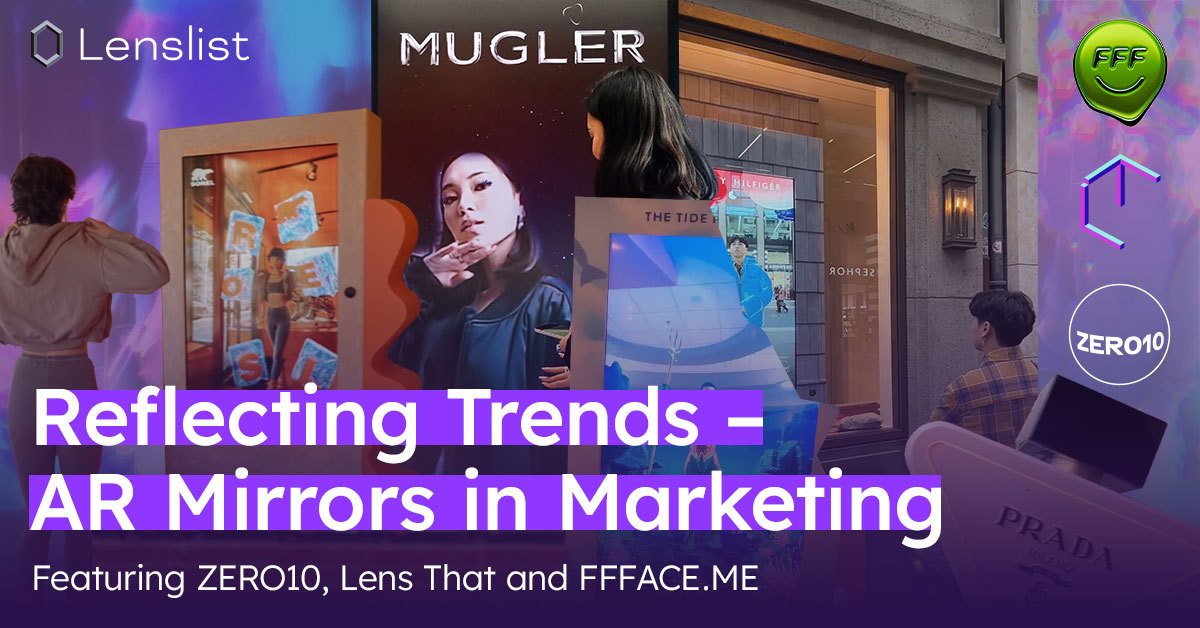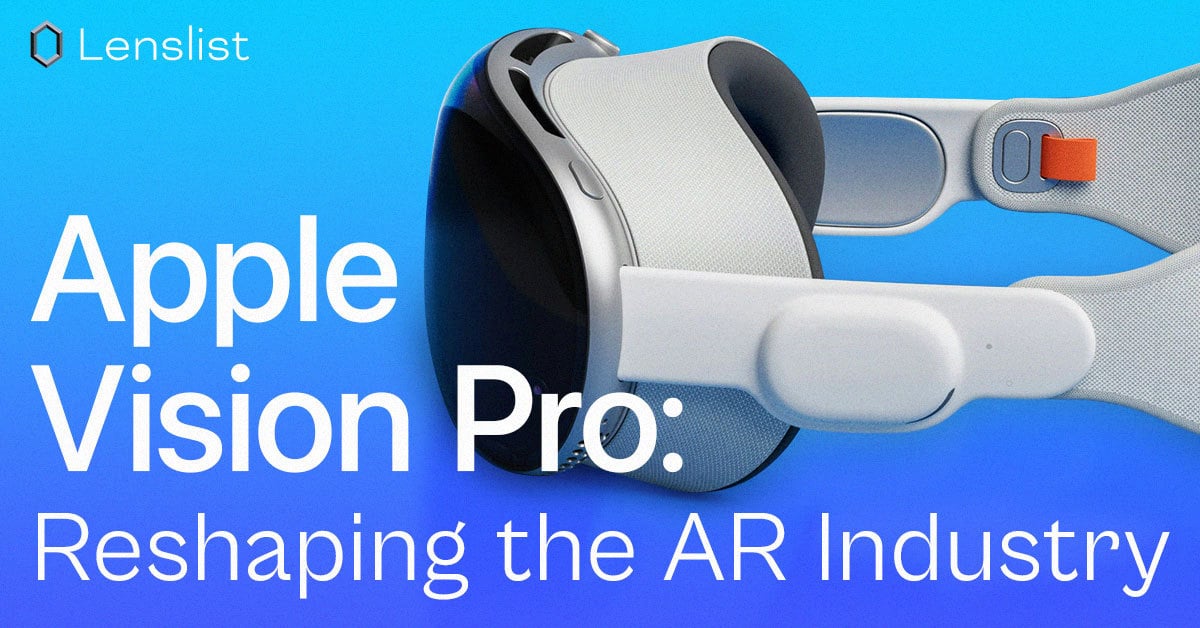Reflecting Trends – AR Mirrors in Marketing and Retail

AR technology evolves each day, creating both innovative and effective solutions for retailers, both when it comes to communication and sales. And today, we want to talk about AR mirrors: one of the most practical and impressive use cases for augmented reality marketing.
With such competition in retail, choosing the right marketing strategy is the first step to success in standing out from the crowd. How can brands create truly unforgettable communication and build a community of engaged customers and ambassadors? Our answer, as always, is Augmented Reality. And right now, AR mirrors are one of the fastest-growing trends in the industry.
We already mentioned AR Mirrors in our 2024 AR Predictions as one of the key points of the year, but it was just the tip of the iceberg. The popularity of AR Mirrors is constantly growing, making it a widely appreciated communication tool among industries.
To learn even more about the concept of AR Mirrors, we asked some of the best specialists in the field about the subject. Scroll to learn how ZERO10, FFFACE.ME and Lens That delivered AR Mirrors for brands such as Coach, Maybelline or McDonald’s.
What Exactly Is an AR Mirror?
Just like each typical mirror, the device allows users to see accurate reflections of themselves. Yet, the similarities end there: Augmented Reality mirrors use the camera to add digital objects to the real environment, enabling customers to interact with the virtual content in real life, and using their body movements to steer and customize the experience, for example by using hand gestures.
AR Mirrors in numbers: statistics
When deciding on a way of advertisement, specific numbers are what convinces marketers. How does it look in Augmented Reality marketing – especially considering the try-on features?
👉70% of customers would shop more with AR,
👉32% of customers already use AR while shopping,
👉40% of customers would pay more for the product with an AR customization option,
👉71% of customers want more try-on experiences.
See the full report here.
Smart Mirrors in Fashion
The first thing that comes to mind when we think about using AR mirrors is the fashion industry. The typical fitting room experience is often not the most pleasant one, taking time out of our day and requiring a lot of effort. That’s where digital mirrors can become crucial. Tracking body movements, the device allows for quick and virtually enhanced try-ons, making it easy to match products and try out different styles of clothing. Also, thanks to the obvious connection with actual mirrors, using AR displays is very intuitive and doesn’t require instructions or special introductions – once the user is in the camera view, you just can’t look away.
by Tommy Hilfiger
by UGG
But how can retailers access the magic of smart mirrors? Collaboration. Many global fashion brands have already joined forces with tech partners to create interactive experiences using AR capabilities.
For example, ZERO10’s proprietary technology has already made a huge difference in the fashion industry, significantly enhancing the shopping experience for customers worldwide.
What impact can AR mirrors have on the fashion industry?
As a leading AR try-on company, ZERO10 recognizes the challenges marketers face in today’s saturated advertising landscape. With consumers bombarded by countless messages across various platforms, it’s crucial for brands to stand out and create memorable experiences. Take, for instance, the average attention span when encountering formats like the digital signage screen — a mere 4 seconds demands the conveyance of key messages within 1.5-2 seconds.
Moreover, with digital signage often situated in bustling areas, effective communication between brand and customer becomes a formidable task. However, the AR Mirror, our core business product, presents a solution with its extended attention span, enhancing brand recognition and facilitating social media content creation. Its interactive nature allows consumers to immerse themselves in brand experiences, resulting in an impressive 9X engagement rate. This aligns perfectly with the growing desire for interactive brand experiences, particularly among younger demographics.
Last year, we installed more than 50 AR Mirrors across the globe with more than 15 brands and retailers. Some of these include Coach, Tommy Hilfiger, Calvin Klein, UGG, Macy’s, JD Sports, Nike, Disney, Warner Bros., Oroton, and others. For one of our projects in Miami for the holiday season, we conducted a performance comparison between the AR Storefront and a traditional display window, revealing at least a 4.37x higher engagement rate for the virtual try-on experience. This demonstrates that integrating AR Mirrors and virtual try-on experiences into stores is an effective way to attract and capture customer attention, especially during the busiest retail times of the year, including Black Friday and Christmas, potentially driving foot traffic into stores.
– Ariana Dzhanbaz, CMO at ZERO10
More Opportunities
While the fashion industry is most often associated with the use of AR Mirrors, there’s potential with other industries as well. Many companies already proved that creativity is often the only obstacle when it comes to the mirror’s use.
Gamification
Some of the Augmented Reality mirrors focus more on the subject of gamification, engaging the users to spend more time with the experience. For example, the McDonald’s Interactive AR Mirror, created by Lens That, aims for friendly competition: standing next to each other, users can interact with the AR content, at the same time engaging with each other in the physical world.
At the same time, creating its own immersive games, Lego focused more on allowing customers from across the world to play together in the AR Snow Throw competition. The Smart Mirror was placed outside the Lego stores in New York and London, with passersby able to use the AR technology in real-time.
Art
Augmented Reality in itself is a form of art, and AR Mirrors can be a great way to enhance the immersion of users into the world of vibrant shapes and colors. The technology can bring iconic paintings, fashion pieces, and exhibitions to life, often virtually putting art directly on the viewers. Just as the Design Museum in London was putting the digital clothing and makeup from some of the iconic fashion designers with Snapchat filters in the AR Mirrors.
by designmuseumlondon and @beyondxstudio
by Samsung
by Snapchat x British Fashion Council
As Lenslist, we collaborated with the Max Ernst Museum on the Surreal Futures exhibition using the AR Mirror technology. Each month, visitors could immerse themselves in the world of a new Snapchat filter created by some of the most innovative artists. The abstract world full of shapes, textures and colours was open to museum visitors wishing to escape reality and dive into the universe of digital art.
Out-of-Home Marketing
OOH advertising is quickly gaining popularity among brands that want to reach customers IRL and go back to the basics, but in a new, refined way allowing for the online and offline to connect. While marketers should definitely engage with potential customers in real life, augmented reality technology is a great way to digitally enhance the experience while still staying in the physical world. Whether it’s a standard billboard with virtual objects flowing around or an interactive AR Mirror, there’s a promise of increased customer engagement.
But brands can go even further. Maybelline joined forces with FFFACE.ME Agency, already known for its innovative and creative approach to advertisement, and connected the idea of a smart mirror and interactive billboard. With the technology, users could feel like true campaign stars, seeing their faces on the huge screen above the busy streets of Kyiv. Tracking the user’s face, AR technology added a virtual makeup glam, allowing the try-on of the beauty brand’s products.
Events
AR Mirrors can also become an interesting addition to all kinds of events, whether cultural or promotional. AR Technology provides customers with extra entertainment, engaging attendees with games, beauty makeovers, clothes try-ons and more.
For example, guests of the ELLE UK Style Awards 2023 (including influencers, celebrities and fashion designers) could use augmented reality to see themselves on the cover of the magazine or interact with digital information in the physical world. Similarly, Warner Bros. Entertainment partnered with ZERO10 to create an unforgettable, immersive experience for the premiere of the Aquaman movie. Coming to the event, viewers could stand in front of the AR Mirror to see themselves as the main character of the movie. No costumes needed!
Another example of innovative designers aiming at reshaping the relationship between technology and retail is Beyond Studio. By working with 3D and Augmented Reality, they are transforming the user experience, providing an interactive and immersive way to try on products and increase customer engagement.
by Elle and @beyondxstudio
by Elle and @beyondxstudio
by ZERO10 x Aquaman
Why should more brands include AR Mirrors in their campaigns?
The era of conventional advertising materials offering static or video content for passive consumption is ending. Similar to the online phenomenon known as “banner blindness,” we now observe a parallel trend offline. People no longer engage with traditional advertising materials, prompting the need for revitalization through interactivity. When individuals peer into a mirror, they not only see the product in action but also capture attention as their faces appear on a screen.
AR Mirrors serve as interactive installations where creative concepts and engagement mechanisms are realized through digital content. This digital content can be updated without physical production, making it a more sustainable option compared to traditional advertising structures that lack reusability. Updating a classic non-standard advertising installation typically involves constructing and dismantling the previous one, whereas updating an AR Mirror simply requires replacing the file.
We anticipate that AR mirrors will become prevalent across the retail industry as they offer the most effective means of emotionally connecting with audiences in real-time.
– Polina Klekovkina, COO & Partner at FFFACE.ME Inc
Advantages of AR Mirrors
Retail stores from various industries already recognized the significant benefits that come from using Augmented Reality Mirrors in their marketing. What are they? Let’s start with the higher engagement rate and in-store traffic. AR Mirror sparks the curiosity of the customers, becoming not only a practical feature but also an additional entertainment. As a result, brands are reaching new crowds and building stronger relationships with their customers. At the same time, it provides differentiation. Using Digital Mirrors makes the brand stand out from the crowd, promising entertainment instead of plain advertising.
In retail, however, the most important part is the benefits of virtual try-ons. Such product visualization enables customers to try the products quickly and easily, making more informed decisions, which can easily reduce returns. All of it leads to increased customer satisfaction, allowing consumers to save the time and effort normally required in the fitting room.
Can AR Mirrors become the go-to form of promotion?
I don’t see why they wouldn’t become a widely applied communication and promotion tool by brands from numerous industries. There are plenty of potential use cases, plenty of goals an AR Mirror can help achieve along the consumer journey, and virtually no adoption barriers for the end users – all a person needs to do is stand in front of one.
Plus, the emergence of AR Mirrors happens in very fitting times – it coincides, or maybe is a result of, the rise of “all things experiential”: stores are shopping experiences now, branded events must include a plethora of engaging, contextual activities, even OOH ads must deliver some kind of AR-enhanced, immersive experiences.
– Jan Ożarowski, Extended Reality Creative Strategist & Partner at Lens That
Read more from Lens That about AR Mirrors here.
Want to learn more about AR Mirrors? Contact us and watch your marketing reach new levels of creativity!





